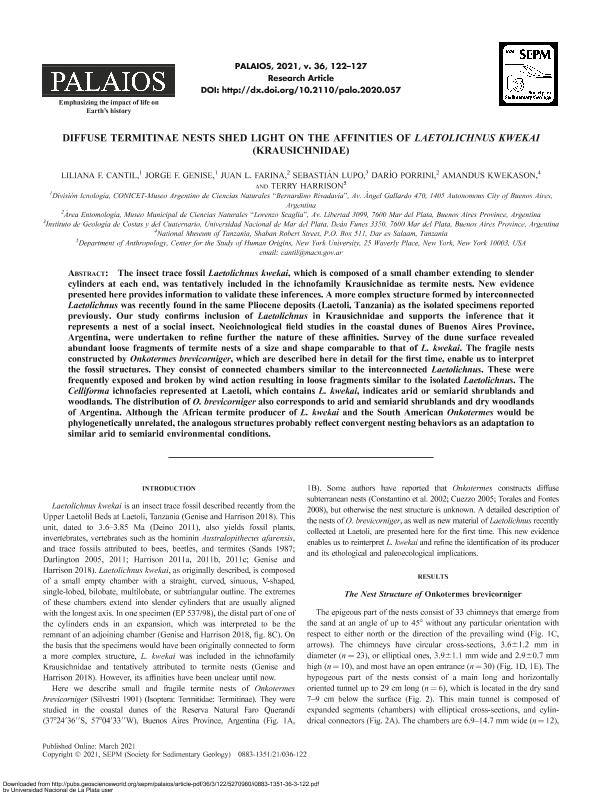Mostrar el registro sencillo del ítem
dc.contributor.author
Cantil, Liliana Fernanda

dc.contributor.author
Genise, Jorge Fernando

dc.contributor.author
Farina, Juan Luis

dc.contributor.author
Lupo, Sebastián Daniel

dc.contributor.author
Porrini, Darío Pablo

dc.contributor.author
Kwekason, Amandus
dc.contributor.author
Harrison, Terry
dc.date.available
2022-01-18T14:44:55Z
dc.date.issued
2021-03
dc.identifier.citation
Cantil, Liliana Fernanda; Genise, Jorge Fernando; Farina, Juan Luis; Lupo, Sebastián Daniel; Porrini, Darío Pablo; et al.; Diffuse termitinae nests shed light on the affinities of Laetolichnus kwekai (Krausichnidae); Society for Sedimentary Geology; Palaios; 36; 3; 3-2021; 122-127
dc.identifier.issn
0883-1351
dc.identifier.uri
http://hdl.handle.net/11336/150227
dc.description.abstract
The insect trace fossil Laetolichnus kwekai, which is composed of a small chamber extending to slender cylinders at each end, was tentatively included in the ichnofamily Krausichnidae as termite nests. New evidence presented here provides information to validate these inferences. A more complex structure formed by interconnected Laetolichnus was recently found in the same Pliocene deposits (Laetoli, Tanzania) as the isolated specimens reported previously. Our study confirms inclusion of Laetolichnus in Krausichnidae and supports the inference that it represents a nest of a social insect. Neoichnological field studies in the coastal dunes of Buenos Aires Province, Argentina, were undertaken to refine further the nature of these affinities. Survey of the dune surface revealed abundant loose fragments of termite nests of a size and shape comparable to that of L. kwekai. The fragile nests constructed by Onkotermes brevicorniger, which are described here in detail for the first time, enable us to interpret the fossil structures. They consist of connected chambers similar to the interconnected Laetolichnus. These were frequently exposed and broken by wind action resulting in loose fragments similar to the isolated Laetolichnus. The Celliforma ichnofacies represented at Laetoli, which contains L. kwekai, indicates arid or semiarid shrublands and woodlands. The distribution of O. brevicorniger also corresponds to arid and semiarid shrublands and dry woodlands of Argentina. Although the African termite producer of L. kwekai and the South American Onkotermes would be phylogenetically unrelated, the analogous structures probably reflect convergent nesting behaviors as an adaptation to similar arid to semiarid environmental conditions.
dc.format
application/pdf
dc.language.iso
eng
dc.publisher
Society for Sedimentary Geology

dc.rights
info:eu-repo/semantics/openAccess
dc.rights.uri
https://creativecommons.org/licenses/by-nc-sa/2.5/ar/
dc.subject
LAETOLICHNUS KWEKAI
dc.subject
ONKOTERMES BREVICORNIGER
dc.subject
TERMITINAE NESTS
dc.subject
CELLIFORMA ICHNOFACIES
dc.subject.classification
Zoología, Ornitología, Entomología, Etología

dc.subject.classification
Ciencias Biológicas

dc.subject.classification
CIENCIAS NATURALES Y EXACTAS

dc.title
Diffuse termitinae nests shed light on the affinities of Laetolichnus kwekai (Krausichnidae)
dc.type
info:eu-repo/semantics/article
dc.type
info:ar-repo/semantics/artículo
dc.type
info:eu-repo/semantics/publishedVersion
dc.date.updated
2021-12-03T21:36:07Z
dc.journal.volume
36
dc.journal.number
3
dc.journal.pagination
122-127
dc.journal.pais
Estados Unidos

dc.journal.ciudad
Lawrence
dc.description.fil
Fil: Cantil, Liliana Fernanda. Consejo Nacional de Investigaciones Científicas y Técnicas. Oficina de Coordinación Administrativa Parque Centenario. Museo Argentino de Ciencias Naturales "Bernardino Rivadavia"; Argentina
dc.description.fil
Fil: Genise, Jorge Fernando. Consejo Nacional de Investigaciones Científicas y Técnicas. Oficina de Coordinación Administrativa Parque Centenario. Museo Argentino de Ciencias Naturales "Bernardino Rivadavia"; Argentina
dc.description.fil
Fil: Farina, Juan Luis. Provincia de Buenos Aires. Municipalidad de General Pueyrredon. Secretaría de Cultura. Museo Municipal de Ciencias Naturales Lorenzo Scaglia; Argentina
dc.description.fil
Fil: Lupo, Sebastián Daniel. Universidad Nacional de Mar del Plata. Facultad de Ciencias Exactas y Naturales. Instituto de Geología de Costas y del Cuaternario. Provincia de Buenos Aires. Gobernación. Comisión de Investigaciones Científicas. Instituto de Geología de Costas y del Cuaternario; Argentina
dc.description.fil
Fil: Porrini, Darío Pablo. Provincia de Buenos Aires. Municipalidad de General Pueyrredon. Secretaría de Cultura. Museo Municipal de Ciencias Naturales Lorenzo Scaglia; Argentina. Consejo Nacional de Investigaciones Científicas y Técnicas; Argentina
dc.description.fil
Fil: Kwekason, Amandus. National Museum of Tanzania; Tanzania
dc.description.fil
Fil: Harrison, Terry. University of New York; Estados Unidos
dc.journal.title
Palaios

dc.relation.alternativeid
info:eu-repo/semantics/altIdentifier/doi/http://dx.doi.org/10.2110/palo.2020.057
dc.relation.alternativeid
info:eu-repo/semantics/altIdentifier/url/https://pubs.geoscienceworld.org/sepm/palaios/article/36/3/122/595635/DIFFUSE-TERMITINAE-NESTS-SHED-LIGHT-ON-THE
Archivos asociados
